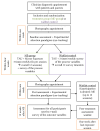Mirror Exposure Training for Adolescents With Anorexia Nervosa (MIRADAN): Cognitive Mechanisms of Body Disturbance - A Study Protocol
- PMID: 38357429
- PMCID: PMC10863679
- DOI: 10.32872/cpe.11277
Mirror Exposure Training for Adolescents With Anorexia Nervosa (MIRADAN): Cognitive Mechanisms of Body Disturbance - A Study Protocol
Abstract
Background: Anorexia Nervosa (AN) is a severe mental illness, which typically develops in adolescence and, if left untreated, often becomes chronic. Body dissatisfaction is a core characteristic of AN. Mirror exposure (ME) is an effective therapeutic technique to tackle body dissatisfaction in adult patients with eating disorders, but there is limited evidence for the effects of ME in adolescence. One potential mechanism underlying effects of ME on body dissatisfaction is change in body-related attention bias. However, this mechanism remains to be empirically tested. Accordingly, the aim of the current study is twofold: primarily, we aim to test if ME can reduce body dissatisfaction and associated symptoms in adolescent patients with AN. Additionally, we aim to investigate whether change in biased body-related attention due to ME is a possible mechanism of action.
Method: Adolescent patients with AN are randomized to either 12 sessions of ME (3 ME-sessions/week) or wait-list within four weeks. Main outcomes include body dissatisfaction and associated symptoms of AN. Moreover, body-related attention bias is assessed at baseline and post-treatment by means of eye-tracking with two paradigms. Further, process variables are collected weekly. In addition, 12 weeks after end of the study, the acceptability of the ME is assessed.
Discussion: The main aim of the study is to evaluate high-frequency and high-intense ME for treating body dissatisfaction in adolescents with AN. In addition, we would like to clarify whether change in attentional bias for body stimuli is a mechanism underlying change in body dissatisfaction due to ME.
Keywords: adolescence; anorexia nervosa; body dissatisfaction; mirror exposure; modifying attentional processes.
Conflict of interest statement
The authors have declared that no competing interests exist.
Similar articles
-
What happens in the course of positive mirror exposure? Effects on eating pathology, body satisfaction, affect, and subjective physiological arousal in patients with anorexia and bulimia nervosa.Eur Eat Disord Rev. 2022 Nov;30(6):797-814. doi: 10.1002/erv.2929. Epub 2022 Jun 22. Eur Eat Disord Rev. 2022. PMID: 35731138
-
Computer Based Body Exposure in Adolescents With Anorexia Nervosa: A Study Protocol.Front Psychiatry. 2022 Jan 24;12:769239. doi: 10.3389/fpsyt.2021.769239. eCollection 2021. Front Psychiatry. 2022. PMID: 35140637 Free PMC article.
-
Selective Visual Attention Towards Oneself and Associated State Body Satisfaction: an Eye-Tracking Study in Adolescents with Different Types of Eating Disorders.J Abnorm Child Psychol. 2017 Nov;45(8):1647-1661. doi: 10.1007/s10802-017-0263-z. J Abnorm Child Psychol. 2017. PMID: 28133705
-
Inpatient versus outpatient care, partial hospitalisation and waiting list for people with eating disorders.Cochrane Database Syst Rev. 2019 Jan 21;1(1):CD010827. doi: 10.1002/14651858.CD010827.pub2. Cochrane Database Syst Rev. 2019. PMID: 30663033 Free PMC article.
-
Body image disturbance in children and adolescents with eating disorders. Current evidence and future directions.Z Kinder Jugendpsychiatr Psychother. 2014 Jan;42(1):51-9. doi: 10.1024/1422-4917/a000269. Z Kinder Jugendpsychiatr Psychother. 2014. PMID: 24365963 Review.
References
-
- Bauer, A., Schneider, S., Waldorf, M., Braks, K., Huber, T. J., Adolph, D., & Vocks, S. (2017). Selective visual attention towards oneself and associated state body satisfaction: An eye-tracking study in adolescents with different types of eating disorders. Journal of Abnormal Child Psychology, 45(8), 1647–1661. 10.1007/s10802-017-0263-z - DOI - PubMed
-
- Beck, A. T., Steer, R. A., & Brown, G. K. (1996). Manual for the Beck Depression Inventory – II. Psychological Corporation.
LinkOut - more resources
Full Text Sources

